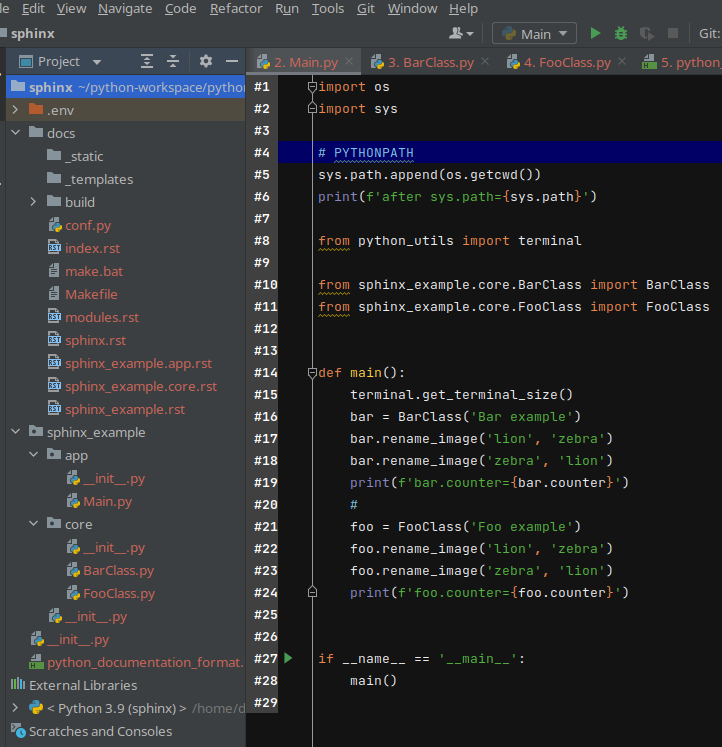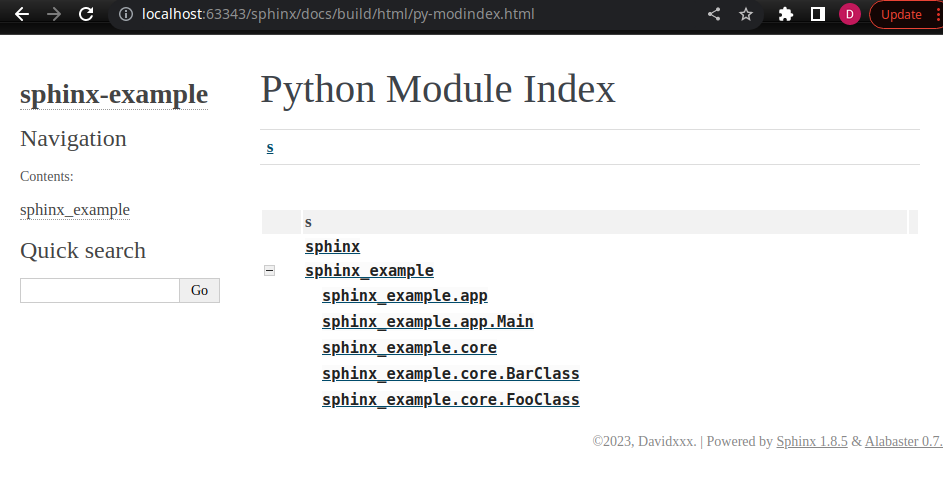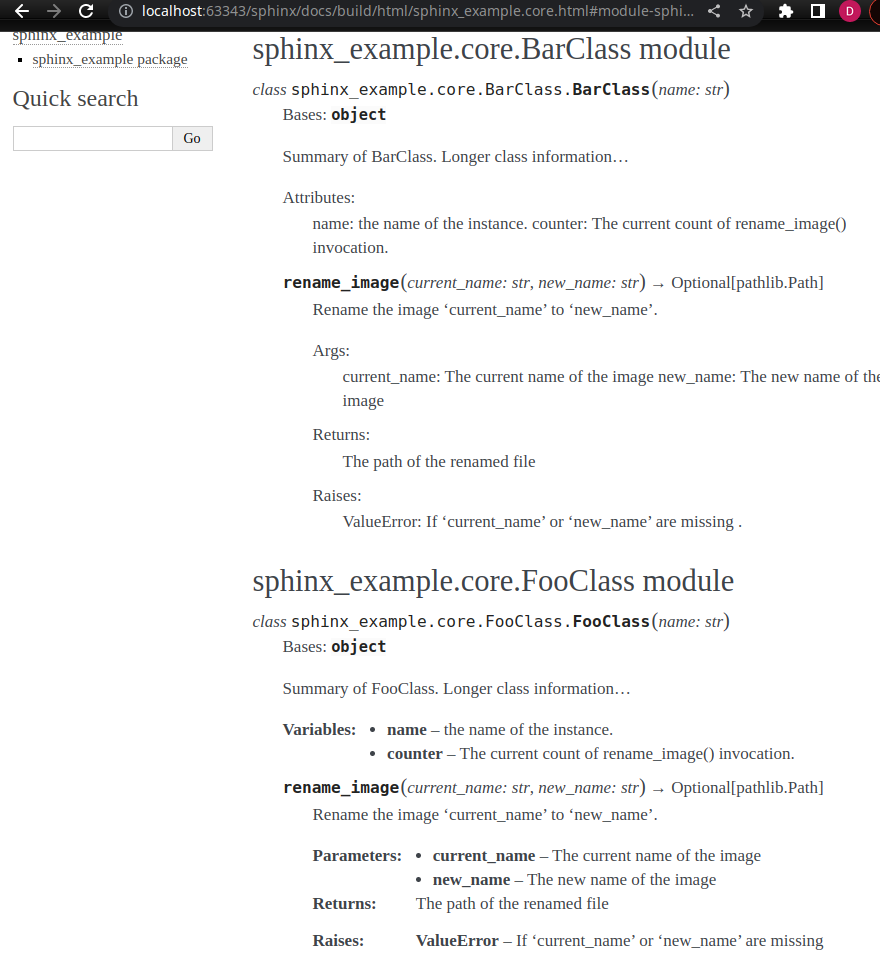Main docstring formats
In Python, they are multiple docstring formats.
There is an official format: reStructuredText but there are also not official but very used formats.
– reStructuredText:
Official Python documentation standard. It has many features but it is also very verbose and tricky.
– Google docstrings:
It is a very simplified docstring format.
– NumPy/SciPy docstrings:
It is a simplified docstring format.
– Epytext:
A Python adaptation of Epydoc. Similar to javadoc.
reStructuredText docstring examples
Note: The new lines are mandatory between sections.
from pathlib import Path from typing import Optional from python_utils import timeout_generator class BarClass: """Summary of BarClass. Longer class information... Attributes: name: the name of the instance. counter: The current count of rename_image() invocation. """ def __init__(self, name: str): """Init BarClass with name and counter.""" self.name = name self.counter = 0 def rename_image(self, current_name: str, new_name: str) -> Optional[Path]: """ Rename the image 'current_name' to 'new_name'. Args: current_name: The current name of the image new_name: The new name of the image Returns: The path of the renamed file Raises: ValueError: If 'current_name' or 'new_name' are missing . """ if not current_name: raise ValueError('The current_name parameter cannot be none') if not new_name: raise ValueError('The new_name parameter cannot be none') self.counter += 1 for i in timeout_generator(3): try: return Path('...') except Exception as e: print(f'try {i + 1} fails, e={e}') return None |
Google docstring examples
Note: The new lines are mandatory between sections.
from pathlib import Path from typing import Optional from python_utils import timeout_generator class BarClass: """Summary of BarClass. Longer class information... Attributes: name: the name of the instance. counter: The current count of rename_image() invocation. """ def __init__(self, name: str): """Init BarClass with name and counter.""" self.name = name self.counter = 0 def rename_image(self, current_name: str, new_name: str) -> Optional[Path]: """ Rename the image 'current_name' to 'new_name'. Args: current_name: The current name of the image new_name: The new name of the image Returns: The path of the renamed file Raises: ValueError: If 'current_name' or 'new_name' are missing . """ if not current_name: raise ValueError('The current_name parameter cannot be none') if not new_name: raise ValueError('The new_name parameter cannot be none') self.counter += 1 for i in timeout_generator(3): try: return Path('...') except Exception as e: print(f'try {i + 1} fails, e={e}') return None |
Sphinx
Overview
Common and powerful library to generate documentation from Docstrings in the code.
Concretely, Sphinx generates two kinds of output:
– it takes as input source code containing docstring and generates .rst files as output.
– it takes as input .rst files and generate as output a documentation in the specified format (.html, .pdf, …).
The docstring formats presented above are all compatible with Sphinx.
But: if we don’t use reStructuredText, we may need to use a sphinx extension (napoleon) to generate .rst files.
Install sphinx inside the virtual environment
If our project use a virtual environment or specific library requirement, we need to install sphinx inside it too to have all dependencies in the path .
pip install sphinx
Setting up the documentation sources
The root directory of a Sphinx collection of plain-text document sources is called the source directory.
The source directory contain (not exhaustive) :
– the configuration file conf.py, where you can configure all aspects of how Sphinx reads your sources and builds your documentation.
– a root document, index.rst. It is a welcome page that contains the root of the « table of contents tree » (or toctree).
Generally, we need to customize it according to our requirements.
– make.bat and a makefile : to build HTML docs in the build directory you chose.
To set up a source directory and creates a default configuration, you create a docs directory at the root of the project and go inside it from your
shell to execute the next command.
– Interactive mode:
sphinx-quickstart
– Quiet mode (with mandatory options provided):
sphinx-quickstart -q -p sphinx-example -a Davidxxx -v 1.0
By default it doesn’t separate source(rst,conf,makefile…) and build(html,…) for documentation.
Generate sphinx/rst files for all modules with the autodoc extension
To do that, we need to add the autodoc extension and enable it in the conf.py:
extensions = [ 'sphinx.ext.autodoc', 'sphinx.ext.autosummary', ] autosummary_generate = True # Turn on sphinx.ext.autosummary |
Assume you have this layout:
– sphinx: the root directory
– docs: the documentations directory
– sphinx_example: the path to the Python module to document
From the root project (…sphinx$ ), we can generate the rst files in this way :
sphinx-apidoc -f -o docs ./sphinx_example/
We could have as output something like:
Creating file docs/sphinx_example.rst. Creating file docs/sphinx_example.app.rst. Creating file docs/sphinx_example.core.rst. Creating file docs/modules.rst. |
Generate documentation files from modules sources and generated rst files
To do that, we need to do first some modifications:
– modify the index.rst file to render the modules.rst file:
Welcome to sphinx-example's documentation! ========================================== .. toctree:: :maxdepth: 2 :caption: Contents: module |
– modify the PYTHON path to have all sources in it and mock any import of our source code that may be annoying during the generation .
Indeed, the generation of the documentation use by default as python path the directory where the conf.rst file is located.
So, generally we need to modify it.
With our layout, we need to do that:
import os import sys sys.path.insert(0, os.path.abspath('..')) print(f'sys.path={sys.path}') autodoc_mock_imports = ["python_utils"] |
Now, we are ready to generate the html documentation files.
sphinx-build way:
Here the general syntax:
sphinx-build -b html sourcedir builddir
Where sourcedir is the source directory(That is that contains the rst files), and builddir is the directory in which you want to
place the built
documentation.
The -b option selects a builder.
In our case, from the root project we do that:
sphinx-build -v -b html docs docs/build/html/
make way:
In our case, from the docs project we need to do that:
make html
Whatever the way, the result is the same. We should see at the end of the execution the writing of modules and submodules documentation:
writing output... [ 20%] index writing output... [ 40%] modules writing output... [ 60%] sphinx_example writing output... [ 80%] sphinx_example.app writing output... [100%] sphinx_example.core |
We can see the documentation for all modules and submodules where generated:
We can see in this preview, to modules documentations with the same source code but using to distinct docstring formats.
BarClass uses Google docstring and FooClass uses reStructuredText docstring:
